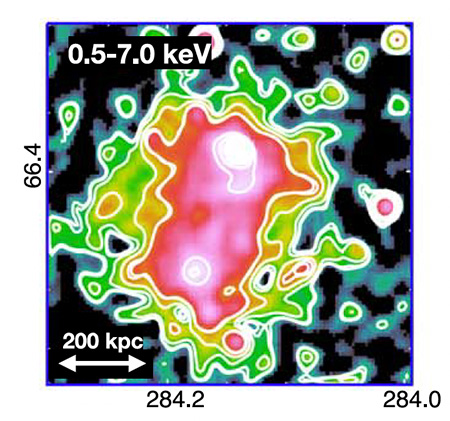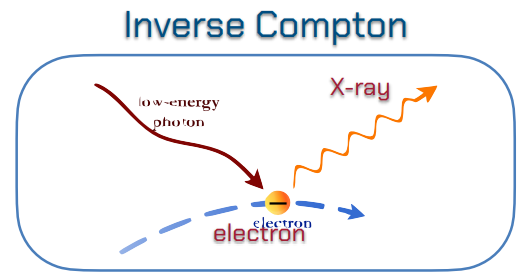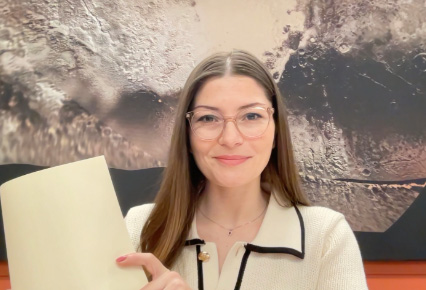So…I arrived in Cape Town late on Wednesday, got a few hours of sleep, and then took a tour of some sites of scientific importance in the area. On the bus I met Ayşegül Tümer, a Turkish post-doctoral fellow at MIT, whose works in x-ray astronomy. If you think that x-rays are found only in medical settings you might wonder if she is a doctor to the stars…it turns out that, while she’s not that kind of a doctor and she’s not really interested in anything as small as a star, she does use x-rays to help diagnose bumps and bruises on a multi-galactic scale.
Things clump together in the universe. A bunch of atoms clumped together eons ago to form dust and sand; dust and sand clumped together to form the Earth; planets, comets, asteroids, and the Sun clumped together to form our Solar System. This clumping continues at ever-larger levels; billions of stars and clouds of gas and dust clumped together to form our galaxy, which is one of many galaxies clumped together in the Local Group, and even clusters of galaxies will interact and merge – and then things can get very interesting!
The energy of radiation is a function of the amount of energy that goes into creating it – high-energy radiation in the form of x-rays is only produced in high-energy (and high-temperature) environments. So when Ayşegül sees x-rays coming from the heavens she knows that they’re pointing to high-energy processes – things like black holes, massive clouds of gas slamming into each other at high velocities, exploding stars, and things like that.
What Ayşegül sees in the images she produces show hot spots where gas, millions of degrees in temperature, resides – gas heated by the collisions. When galaxies collide, stars might be ripped from their place in the galaxy to be thrown into intergalactic space, but stars are so small in comparison to the space between the stars that they rarely (if ever) strike each other – just as grains of sand don’t often collide in a sandstorm.

The paper and the full image/figure can be found here: https://iopscience.iop.org/article/10.3847/1538-4357/ad1037/pdf
The same thing happens when clusters of galaxies collide – the actual galaxies might not interact much, but the vast clouds of gas in which they reside slam into each other at high speeds and it’s this gas that lights up in x-ray radiation, and the brighter they shine in x-ray radiation, the denser the gas must be. In addition, these gargantuan events can cause shock waves to form in the gas and these shocks can further heat the gas as well as helping to shape the gas clouds that fill the space between the galaxies and galactic clusters.
In addition to the x-rays from scorching hot (albeit tenuous) gas, Ayşegül sees other intriguing phenomena. If you’ve received radiation safety training, for example, you might remember that when electrons pass through material they can produce x-rays through a process called bremsstrahlung; this is why we use plastic instead of metal to shield beta-emitters. It turns out that, at high temperatures, gas forms a plasma that consists of charged particles and when these charged particles interact with the matter in the gas clouds, they emit bremsstrahlung x-rays in numbers large enough to be seen from over a billion light years away.
On top of that, she also sees signs of an interesting twist on the process of Compton scattering. You might remember that Compton scattering occurs when a gamma ray photon is absorbed by an electron, jumping it to a higher energy level; when the electron drops back down to its normal level it gives off the photon in a random direction and at a slightly lower energy.

What Ayşegül sees, though, is the result of low-energy photons that absorbed by fast-moving electrons and are boosted to a higher energy level by the encounter. If the electrons are moving quickly enough, they can boost photons from microwave (very low) to x-ray (very high) energies. On top of all of this, the high energy of the x-rays gives them a more direct path with less scattering than we see with, say, radio waves – because of this, the x-ray photons Ayşegül observes can help to point to the location of small phenomena such as shock waves that simply can’t be seen in any other way.
To me, the astronomy and astrophysics are simply very cool. But what I love just as much is that the sorts of things that many of us in radiation safety deal with on a regular basis at work – Compton scattering, bremsstrahlung, and x-rays – are also present on a far grander scale that’s totally divorced from what any of us encounter in the lab or in the field. It’s neat to see that things that I teach and work with on a daily basis in the lab are also present on a cosmic scale, yet the underlying physics remains the same.
